Set of models, dummies and measurement data acquisition system

The articulated pedestrian target
The articulated pedestrian target has the silhouette of a typical standing adult pedestrian. The design of the pedestrian dummy allows any clothes to be worn on it. This is a necessary condition if you want to test the influence of clothing on the recognition of pedestrians by vehicle safety systems. The pedestrian dummy was made of high-strength foam without hard and stiff elements. Extremely light and soft structure to prevent damage on VUT (vehicle under test). This design allows a collision with a passenger car even up to 60 km/h. The dummy is delivered with a stable mounting base which enables quick reassembly after a crash test. The robust construction allows testing under rough conditions and the modular system enables an easy and fast change of spare parts.
The bicyclist target
The 4activeBS model consists of an adult foam dummy and a bicycle made of lightweight plastic. The bicyclist target 4activeBS is represents an 50% adult male on standard average European utility bike. It is extremely lightweight and of a soft structure to prevent damage on the VUT (vehicle under test). The silhouette of a cyclist in an upright position shows a typical man with a height of 180 cm, a shoulder width of 50 cm and a chest depth of 23,5 cm. The maximum height of the bicycle with the cyclist is 184 cm and the length is 194 cm. The entire model is resistant to side winds up to 4 m/s and gusts up to 8 m/s. Its modular system allows an easy and fast exchange of spare parts. The device has been designed in such a way that it allows to carry out multiple crash tests with a passenger car even up to 60 km/h in crash speed lateral and up to 45 km/h in the case of longitudinal collisions (running into a bicycle).
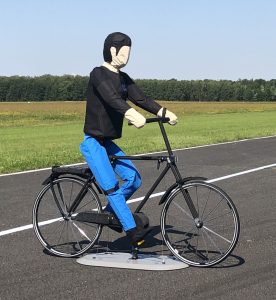
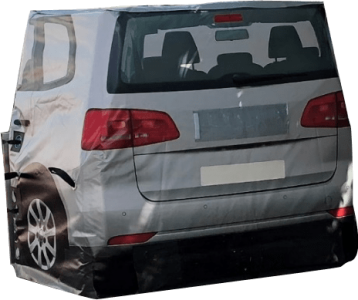
The EVT Vehicle Target
The EuroNCAP Vehicle Target (EVT) was developed to simulate the rear end of a standard production car. It contains an accurate image of passenger car with special reflective elements in accordance with the ECE104 standard, which enable correct recognition using the LIDAR based technology. The materials and coatings used make it suitable for testing all technologies used in collision detection systems. The EVT Vehicle Target conforms to the Euro NCAP specifications as defined in the official AEB test protocol. The structure is made of inflatable elements and spongy fillings, which reduces the risk of damage to the body of an impacting vehicle (VUT), and also allows for multiple crash tests with a passenger car even up to 50 km/h. A radar absorbent foam section is sewn into the bottom to avoid it being lost or forgotten. After impact, the model is able to move on the ground with the base. The device is fully compatible with the towing system.
Towing system for the Vehicle Target (EVT)
The maximum towing speed is 80 km/h. The entire towing system consists of:
- model of rear end of a passenger car,
- φ75 mm rubber hoses connected with a Storz coupling,
- mobile base of the model,
- connection plate mounted on the towbar,
- mobile hose holders.
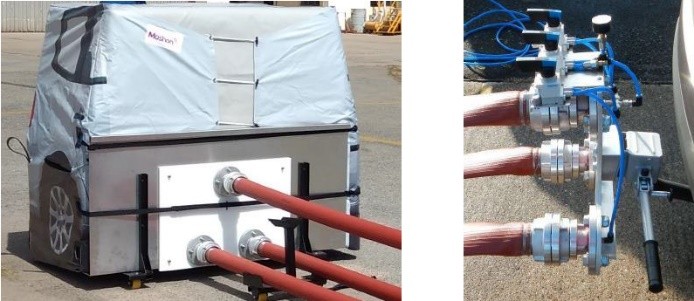
The model of rear end of a passenger car is attached to the mobile base by using special squeezing belts, in addition the base has three slots for mounting rubber hoses. The connection plate is mounted on the towbar of the vehicle and secured with the lever shown in the above photo. As with the mobile base, there are also 3 hoses connection slots. The plate is equipped with a set of three three-position pneumatic distributors that enable pumping, pumping out and complete closure. The recommended pressure in the system is 8 bar, which can be checked using the manometer located in the system. Additionally, the connection plate is equipped with a quick coupler for connecting a compressor.

Static model of the rear end of a passenger car
The static model of rear end of a passenger car corresponds to the EVT model and similarly to the rear end of a typical vehicle is suitable for testing all technologies used in collision detection systems. It is made of light materials that significantly reduce the probability of damage of an impacting vehicle (VUT).
Measurement data acquisition system
The measurement data acquisition system is designed to realize measurements during the tests of vehicle system response. All data collected by the elements of the measurement system, including the image recorded by cameras, must be able to synchronized registration in the data recorder. The most important feature of the entire system is its integrity and the possibility of full synchronization of measurement data from acceleration sensors together with data from cameras, microphones and location sensors. In addition, thanks to wireless communication between the two units, it is also possible to fully synchronize sensor data from two different vehicles.

The entire system consists of:
- portable computer data recorder,
- data acquisition module,
- two random-incidence field microphones,
- one triaxial seat accelerometer,
- two uniaxial accelerometers,
- four web cameras,
- high-speed camera,
- two inertial measurement unit,
- two 3G modems with RTK (Real-Time Kinematic) service.
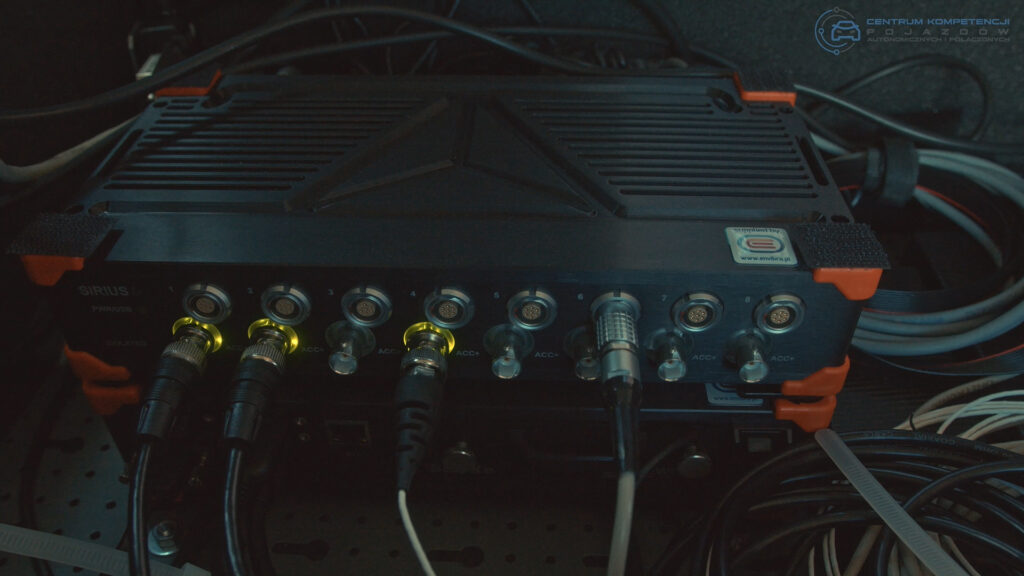
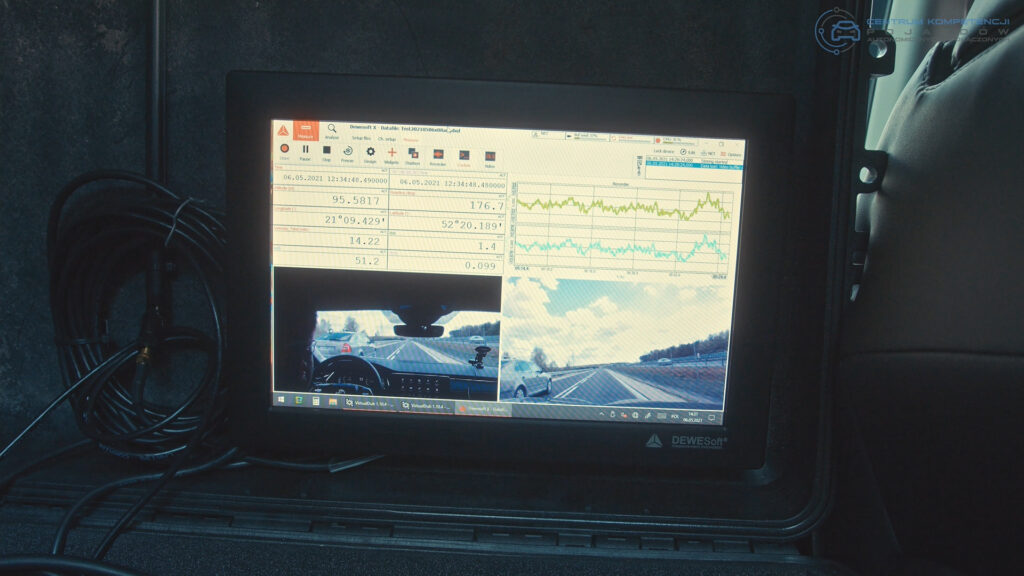
In addition, the set also includes accessories necessary to use the system, including devices necessary for synchronization between vehicles, and a set of connection cables. The data acquisition module is an A/C converter equipped with 8 inputs for microphones and accelerometers, moreover, it is equipped with a dedicated input channel supporting the CAN network in the standard of at least 2.0B. The converter uses a sampling frequency of 200 kHz with 20-bit resolution. The module case meets the standards of durability in field conditions in the MIL-STD-810D standard.
The field microphone has a dynamic range from 17dB(A) to 138 dB(A) and a sensitivity of 50 mV/Pa. The frequency range is from 4 Hz to 12.5 kHz. The device is of the random-incidence type, i.e. it records sounds coming simultaneously from many sides. In addition, the microphone is equipped with a preamplifier. Both accelerometers are equipped with piezoelectric IEPE sensors. The webcam records an image in color at a resolution of 1920 x 1080 pixels at 30 frames per second with two-channel stereo sound. The optics used provides a 75-degree angle of view and allows you to turn off the auto-focus system in a given position. The high-speed camera is equipped with a CMOS photosensitive matrix and allows you to record movies at a speed of 100 frames per second at a resolution of 1920 x 1080 pixels, and even up to 300 frames per second at a resolution of VGA (640 × 480 pixels). The camera is also equipped with a standard C-mount lens thread and provides a 60-degree angle of view.
The Inertial Measurement Unit (IMU) supports GPS L1, L2 and L5, GLONASS L1 and L2, and GALILEO E1 and E5 navigation systems. The device, using the RTK method, is accurate to 10 cm vertically and horizontally. The unit supports course measurement with an accuracy of 0.1 ° and allows you to measure speed with an accuracy of 0.007 m/s at a speed of 200 km/h. The device is equipped with an accelerometer, gyroscope and magnetometer and has a refresh rate of 500 Hz. The case provides protection against dust and water at the IP67 level and meets the standards of durability in field conditions MIL-STD-810D. 3G modem together with RTK-3G service improve the accuracy of coordinate measurement via IMU.

